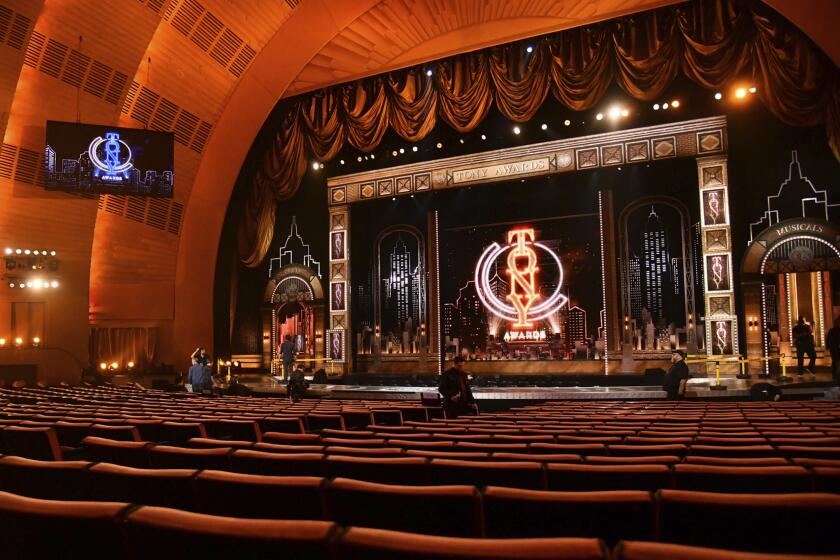ART : Medium Explored as Political-Awareness Tool
- Share via
It probably would have been too much to expect Orange County to deliver a standing-room-only audience for a daylong series of presentations on art as a tool for political awareness. On Saturday, barely two dozen people showed up for an open forum sponsored by the Newport Harbor Art Museum in conjunction with the exhibition “Committed to Print: Social and Political Themes in Recent American Art.” But the listeners--and the speakers--made up in passion what they lacked in numbers.
The morning session was a panel discussion with moderator Karen Atkinson, an art activist and founder of ARTtornies at Work, and artists Cheri Gaulke, co-founder of Sisters of Survival; Robert Sanchez of Border Arts Workshop, and Jordan Peimer of Act-Up L.A.
The afternoon panel included Mark Chamberlain, organizer of the Tell photo-mural in Laguna Canyon; Deborah Small and Louis Hock, who collaborate with others on public art projects in San Diego, and Los Angeles performance artist Tim Miller.
These are artists who look beyond traditional gallery or museum settings to seek out people going about their lives in the real world. Their work includes window displays for store fronts, billboards, murals, postcards, printed stickers, videotapes, leaflets, and performances on city streets, parking lots and beaches.
Atkinson showed images and texts from a continuous slide show on issues of freedom of expression installed in a Cleveland, Ohio, storefront. A quote from German Expressionist painter Otto Dix--whose bitterly satirical works were condemned by the Nazis--sadly recalls how he was “exiled into landscapes.” A witch-hunting congressman in the ‘50s complains that “modern art is Communist because it does not glorify our beautiful country, our cheerful and smiling people. . . .”
Gaulke whizzed through slides of numerous works she has been involved in, ranging from a phone booth performance about female harassment, called “This Ain’t No Heavy Breathing” to an ambitious anti-nuclear piece that involved street exhibits of North American anti-war art in Europe.
She said she is particularly interested in community-based art programs, in which “regular people come on in and have their lives transformed.” In “Post Card Project,” over a three-year period, 300 Los Angelinos learned how to design and print postcards celebrating women they considered heroines--a disparate group including the Virgin of Guadalupe and the woman who invented Liquid Paper.
Sanchez described art pieces that aim to air differences between people on either side of the United States-Mexico border as well as specific illegal alien issues. In “End of the Line,” performed on the beach where the fence marking the San Diego-Tijuana border ends, people costumed as stereotypical border enemies ate together at a table designed to look like a stretch of highway. The point, Sanchez said, was to show “there could be interaction--that this was not always a war zone.”
Peimer said that while the New York chapter of the gay activist group Act-Up was more visual art-oriented, the L.A. chapter was “more theatrical.” Recent events have included bringing an “art penitentiary” with “prisoners” in prison stripes--protesting National Endowment for the Arts grant censorship--to the courtyard of the Dorothy Chandler Pavilion at the Music Center for the opening of the Los Angeles opera season earlier this month. “They ended up getting better reviews than the opera itself,” Peimer cracked.
The panelists were asked at the close of the morning session whether they didn’t feel their art was simply reaffirming opinions already held by their audiences--and, predictably, they all disagreed.
Atkinson said audiences differ radically from each other--some are hostile, others are supportive. She said that when artists interact with their audiences by holding public workshops it is easier to gauge whether the art is having any effect.
A member of the audience said the name of the game was getting people to take action, since people frequently believed in an issue but don’t do anything concrete to effect change.
Miller, also in the audience, noted that even when people appear to be in agreement on a given issue, art can serve to “recharge” energies depleted by fighting the same battle over a protracted period of time.
On the other hand, he added, it is important to ask whether anything has been accomplished. An example of art that led to concrete action was a January, 1989, performance by Act-Up L.A. in front of Los Angeles County-USC Medical Center--a seven-day vigil that resulted in the creation of more (if still insufficient) facilities for AIDS patients.
Reaching the media is a key goal of activist art, Miller said. The art groups don’t have the money to purchase advertising, but some political performance lands on TV news programs where it gets seen by vast audiences who have no connection with the art world.
Gaulke pointed out that even the art world is not uniformly united behind social issues. Hans Haacke’s art, which bluntly attacks corporate greed and other themes close to the pocketbooks of museum trustees and others, has been seen as “incredibly threatening in traditional settings,” she said.
An audience member wanted to know whether the artists felt they were directing their energies in the most fruitful way. “Maybe you could raise money through direct mail and get on TV,” he proposed, rather than making socially engaged art.
“I believe in the power of images,” Gaulke countered. “I want to seize control of that (tool). And this is the most fun way to make change . . . . I couldn’t just serve time organizing things. I need to do something I enjoy.”
Added Peimer: “You are going to make art about something that’s personal. Well, (gay issues) are so much a part of my life that I couldn’t conceive of doing anything else.”
More to Read
The biggest entertainment stories
Get our big stories about Hollywood, film, television, music, arts, culture and more right in your inbox as soon as they publish.
You may occasionally receive promotional content from the Los Angeles Times.










